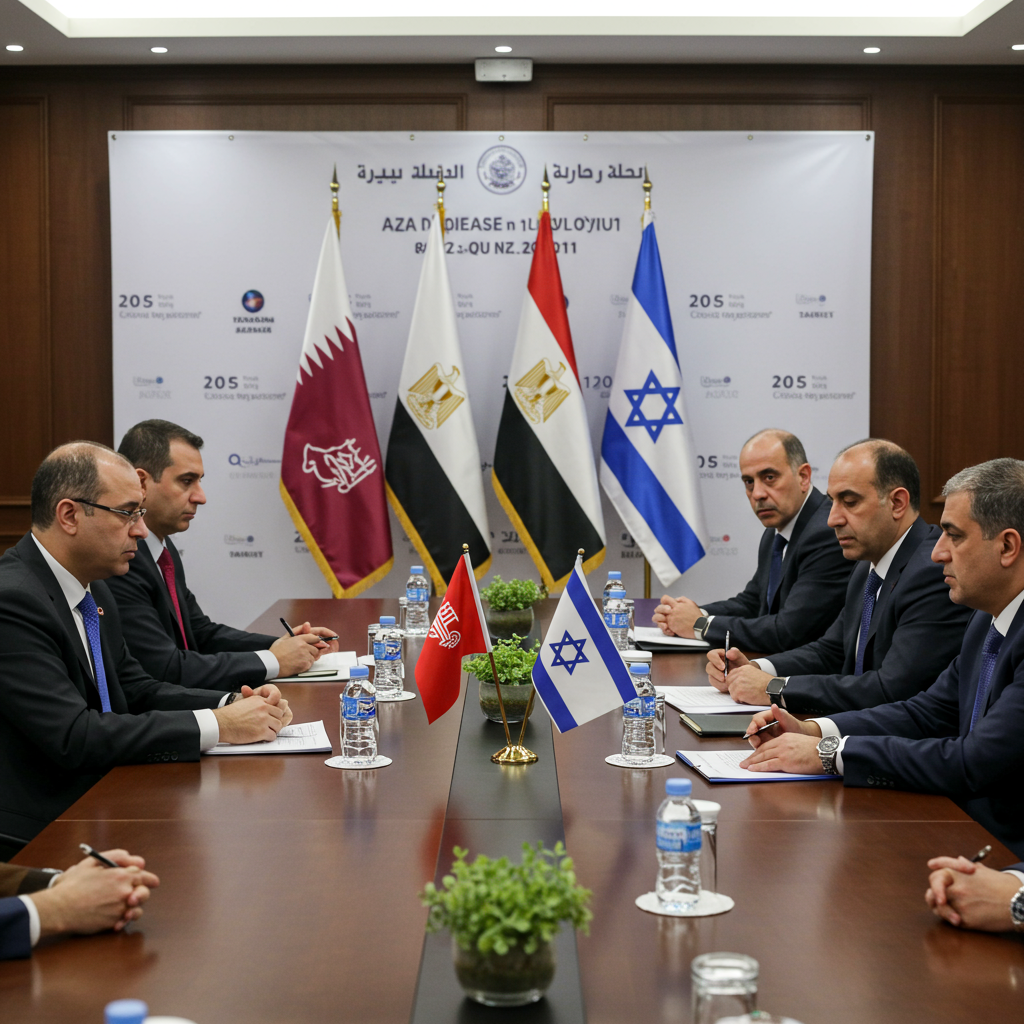hamas has signaled a potential breakthrough in the protracted conflict in Gaza, indicating a positive stance on the latest ceasefire proposal. The group announced its readiness to immediately enter into negotiations with Israel. This development, conveying a “positive spirit,” offers a glimmer of hope for pausing the nearly 21-month-long hostilities and securing the release of remaining captives. Mediated by Qatar and Egypt, the United States-backed framework aims for a significant pause in fighting to allow for complex implementation discussions.
This move marks a crucial step forward after months of stalled efforts and intense military pressure on Hamas. While the initial response is encouraging, significant hurdles remain. Negotiators face the challenge of hammering out the precise mechanisms for implementing the proposed terms. The details of Hamas’s specific requests for amendments or clarifications were not immediately disclosed, adding to the uncertainty surrounding the path ahead.
Understanding the Proposed Ceasefire Framework
The framework for the potential 60-day truce, reportedly guaranteed by US President Donald Trump, lays out a multi-phased approach to de-escalate the conflict. A central element involves the exchange of Israeli captives held by Hamas for Palestinian prisoners held by Israel. The proposal reportedly details a staggered release schedule for 10 live Israeli captives and the bodies of 18 deceased captives from a specified list of 58.
Under this proposed timeline, eight live captives would be released on day one. The bodies of five deceased captives would follow on day seven. Another five bodies would be released on day 30. Two more live captives would be freed on day 50, and the remaining eight bodies on day 60. This specific pacing addresses prior Hamas demands for a phased exchange process.
Crucially, the plan calls for a significant increase in humanitarian aid deliveries into Gaza starting immediately upon the agreement taking effect. Aid quantities would aim for levels comparable to a previous agreement reached in January 2025. Distribution would be managed through established international channels like the United Nations and the Palestine Red Crescent Society. Israeli military operations in Gaza are expected to cease entirely under the terms. This includes halting aerial surveillance flights over Gaza for 10 hours daily, extending to 12 hours on days when captive and prisoner exchanges occur.
Negotiations for a Permanent End to the War
Perhaps the most significant element of the proposal is the mandate for negotiations towards a permanent ceasefire to begin concurrently with the temporary truce. These critical talks are intended to commence on day one of the 60-day pause. Mediators from the US, Egypt, and Qatar would supervise these discussions.
The scope of these negotiations is broad, covering pivotal issues necessary for a lasting resolution. Discussions would encompass the full exchange of all remaining captives for Palestinian prisoners. They would also address the withdrawal of Israeli troops from Gaza, future security arrangements for the territory, and plans for governance in the “day-after” period following the war. The hope is that the temporary truce creates the necessary space for these complex, long-term discussions to succeed.
Hamas’s Conditions and Sticking Points
While describing its response as having a “positive spirit,” Hamas is reportedly seeking firm guarantees that the proposed temporary ceasefire will indeed transition into a permanent end to the war. This core demand has been a major obstacle in previous negotiation rounds. Hamas wants assurances that Israel will not resume military operations once the initial 60-day period concludes or if talks for a permanent deal falter.
Specific demands reportedly put forth by Hamas include the requirement for Israeli troops to pull back to positions they held on March 2, 2025, prior to the breakdown of a previous ceasefire agreement. The group also insists on ensuring the sufficient and reliable flow of humanitarian aid, explicitly through the United Nations and other international humanitarian agencies. Notably, Hamas reportedly objects to the proposed humanitarian aid fund being managed by an American aid organization. Instead, they advocate for management solely through the UN and Red Crescent, excluding the US entity.
Furthermore, Hamas is reportedly pushing for negotiations to continue beyond the initial 60-day timeframe if needed to reach a comprehensive agreement for a permanent ceasefire and the release of all remaining hostages. While sources suggest Hamas may show some flexibility on issues like weapon smuggling and potentially a symbolic, limited exile of a small number of leaders as part of a broader deal, these points are linked to achieving a complete end to the conflict. The group also reportedly seeks a “central role” in policing and maintaining security in Gaza during any transitional period, asserting their unique ability to ensure public order.
Israel’s Position and Uncertainty
US President Trump has publicly stated that Israel accepted the main conditions of the 60-day truce. However, Israeli Prime Minister Benjamin Netanyahu has not yet publicly endorsed the plan. Israeli government officials are currently reviewing Hamas’s official response. Sources indicate Israel may be seeking written assurances from President Trump. These assurances would reportedly grant Israel the authority to resume operations if it determines Hamas has failed to comply with key terms, such as potential disarmament or the exile of leadership – demands Netanyahu has consistently emphasized as prerequisites for peace.
Netanyahu has repeatedly maintained that Israel will resume fighting to ensure the destruction of Hamas. This position is partly influenced by the need to maintain support from his far-right coalition allies. Despite this, opinion polls reportedly indicate strong Israeli public support for a deal to secure the return of the hostages. Proximity talks, mediated by Qatar and Egypt, are considered highly probable if Hamas’s response remains favorable, with Israel reportedly preparing to approve the deal and dispatch a delegation.
The Broader Context of the Conflict
The current ceasefire efforts unfold against the backdrop of nearly two years of devastating conflict. The war was triggered by the Hamas attacks inside Israel on October 7, 2023, which resulted in the deaths of approximately 1,200 people, mostly civilians. Israel’s subsequent military campaign in Gaza has caused a severe humanitarian crisis. According to the Gaza health ministry, which figures are considered reliable by the UN and Western governments, at least 57,268 Palestinians have been killed and over 130,000 wounded since October 7, 2023. This includes over 6,000 deaths since the breakdown of a previous two-month truce on March 18.
The humanitarian situation in Gaza remains dire, with international pressure mounting to increase aid flows. Aid distribution has faced controversy, including allegations of firing at aid seekers at distribution sites managed by organizations like the Gaza Humanitarian Foundation (GHF), which both GHF and the Israeli military deny, stating only warning shots were fired by the military and no civilians were harmed at GHF sites. The Israeli military claims significant control over 65% of the Gaza Strip and reports killing over 100 Hamas operatives in recent intensified operations. Amidst these conditions, besieged Palestinians in Gaza are anxiously awaiting the outcome of the negotiations, uncertain if this positive response will ultimately bring the violence to an end. Regional perspectives also play a role, with Saudi Arabia emphasizing that a ceasefire in Gaza takes precedence over normalization efforts and critically describing Israeli actions as “completely unnecessary” and “unacceptable.”
Looking Ahead: Navigating the Path to Implementation
Hamas’s positive response in principle represents a critical step forward. However, the focus now shifts to the complex and potentially fraught negotiations regarding the implementation mechanisms of the proposed deal. Israeli officials anticipate further difficulties during these talks, suggesting that the initial positive signal does not guarantee smooth sailing to a finalized agreement.
The mediators, including US Special Envoy Steve Witkoff, are expected to play a crucial role in bridging the remaining gaps. President Trump has reportedly committed to ensuring negotiations continue until a final deal is reached. The key challenge lies in reconciling Hamas’s insistence on a guaranteed permanent end to the war with Israel’s stated objective of dismantling Hamas. The coming days will reveal whether the parties can translate this initial positive signal into a concrete agreement that brings relief to Gaza and facilitates the return of the remaining captives.
Frequently Asked Questions
What is the status of the latest Gaza ceasefire proposal?
Hamas has given a “positive” response to the latest US-backed ceasefire proposal. The group has stated it is ready to immediately enter negotiations with Israel on the implementation mechanism of the framework. This signifies a potential breakthrough in the ongoing efforts to pause the fighting in Gaza.
What are the key terms of the proposed 60-day truce?
The US-backed proposal suggests a 60-day pause in fighting. It includes a phased exchange of 10 live Israeli captives and 18 bodies for Palestinian prisoners. It mandates a significant increase in humanitarian aid into Gaza via international agencies like the UN and Red Crescent. The proposal also requires a halt to Israeli military operations and aerial surveillance (with daily pauses). Crucially, negotiations for a permanent ceasefire are scheduled to begin on day one of the truce.
What are the main obstacles to a permanent Gaza ceasefire deal?
Despite the positive initial response, significant obstacles remain. Hamas’s core demand is a guarantee that the temporary truce will lead to a permanent end to the war, which conflicts with Israel’s stated goal of dismantling Hamas. Disagreements over implementation details, such as aid distribution management and the extent of Israeli troop withdrawal, are also potential sticking points during negotiations. The need for strong guarantees acceptable to both sides presents a key challenge.
Word Count Check: 1107



